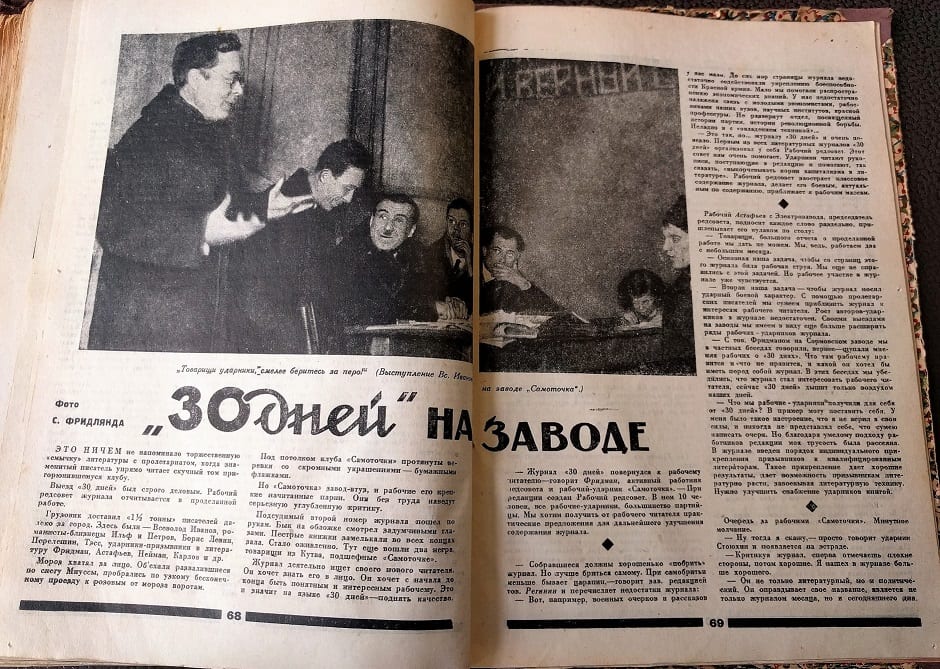Cassio de Oliveira

This blog post is a preliminary study of the readership of the Soviet magazine 30 Days (30 dnei, 1925-1941). Better known nowadays for having been the venue for the publication in installments of Il’ia Il’f and Evgenii Petrov’s famous novels The Twelve Chairs and The Golden Calf (Dvenadtsat’ stul’ev and Zolotoi telenok, published in 1928 and 1931 respectively), 30 Days also holds a unique place in the Soviet publishing environment between the NEP Era and the First Five-Year Plan. In what follows, I shed light on the distinctive features of 30 Days by focusing on archival evidence about the makeup of its readership.
In Modernism in the Magazines, Robert Scholes and Clifford Wulfman argue that understanding a magazine’s readership “will lead us to most of the other elements involved in reading a magazine from the past” (145). This is important because magazines “have a different temporality . . . and are usually intended to be less local” than newspapers (144-145). While this contrast between the geographic range of newspapers and magazines does not fully hold in the Soviet experience—for one thing, Pravda and Izvestiia, the premier Soviet newspapers, enjoyed countrywide circulation—it is true that the topics and types of articles of Soviet magazines and journals differed considerably from their daily counterparts.
In this context, what makes 30 Days unique? The first clue lies in its title, which indicates a monthly circulation rather than the weekly or biweekly runs of counterparts like Ogonek, Prozhektor, or Krokodil.i When we think of monthly Soviet periodicals, we usually picture so-called thick journals such as Novyi mir or Aleksandr Voronskii’s Krasnaia nov’. 30 Days differs significantly from such publications: until 1934, when it became an exclusively literary magazine, it carried extensively illustrated articles of general interest along with sketches (ocherki), poetry, short stories, and the occasional novel and novella in installments. Translated works by left-leaning foreign authors frequently appeared on its pages as well.

While not all of its belles-lettres fare was humorous in nature, the magazine aimed for a lighter touch, with a long-running page dedicated to chess problems and an occasional section devoted to funny and strange news from around the Soviet Union; running through issues from 1930 and 1931, the magazine organized a curious contest entitled “Slovostroi” (“Word-builder”). The goal of Slovostroi was for readers to suggest neologisms that expressed or represented the age of “Socialist Construction” of the First Five-Year Plan, with the best submissions being published in the magazine.ii As the 1930s progressed and the overall tone of the Soviet press became more and more strident, the humor of 30 Days would sometimes turn into sarcasm. For instance, the editorial introductions to a play by Iurii Olesha (Chernyi chelovek) and a story by Isaak Babel’ (“Giui de-Mopassan”), both published in the sixth issue for 1932, mock the quantitatively low productivity of both authors.iii
Especially during its first years of publication, 30 Days frequently sent out surveys to its subscribers. The magazine also organized at least two events intended for editors and writers to get to know their readers, one in the late 1920s (probably 1927), and one in early 1931 (probably in February) at the Samotochka factory in Moscow.iv
What do the 1927 and 1931 readers’ conferences reveal? The 1927 conference allows us to see how the editors articulate their view of the magazine. Vasilii Reginin, the magazine’s longtime editor in charge, affirms that the model for 30 Days is the European (specifically French) magasin, except that, content-wise, 30 Days is focused on themes deemed relevant to a Soviet readership, such as “questions of socialist construction,” in contrast to European “beauty contests” and “pug competitions.” The magazine should be an “organizing force,” Reginin says, helping the reader “participate in the construction of the new life and new culture” (“Vystuplenie na pervoi” 13).v

Notwithstanding Reginin’s statements then and at the 1931 meeting, the workers of the Samotochka factory consistently returned to the question of the intelligentsia readership of 30 Days: comrade Fridman, “a shock-worker of the factory,” claims that the magazine had originally been destined primarily to the “working intelligentsia.”vi Comrade Granek likewise believes that the readers of 30 Days had been, until recently, members of the intelligentsia who wished to read the literary works “for relaxation after a hard day’s work.” He claims that 30 Days has managed to tailor itself to a new (i.e. working class) readership, but also that contemporary literature “should not serve the purpose of relaxation but should rather build the piatiletka [the Five-Year Plan]” (Reginin, “Vystuplenie na vyezdnom” 15-16). The role of literature is evaluated in different ways: one Staiukhin appreciates that 30 Days is not only a literary magazine, but also a political one (12); comrade Denezhkin, on the other hand, argues that “we need literature,” and that it should not be sacrificed to make room for discussions of politics and economy (14).vii
Surprisingly given the increasing amount of space allocated to non-literary texts in 30 Days in the early 1930s, the archival transcript and the write-up of the 1931 meeting demonstrate that readers—at least those of the Samotochka factory—preferred literary works to the articles on the Five-Year Plan that had become ever more pervasive in the magazine. At a time of growing ideological consolidation, these readers actively expected 30 Days to cater to their values, which it did by maintaining a “proletarian editorial board” (rabochii redsovet), for instance.viii Reader involvement in 30 Days illustrates the peculiar role that print culture—both the press and literature, packed into one publication—played in the development of a Soviet “imagined community” (to use Benedict Anderson’s concept), while also demonstrating the amount of wiggle room that a magazine (in contrast to newspapersix) had in defining its editorial line in Stalinist Russia. Finally, it lays bare the artificiality of an us-versus-them mentality regarding the role of the press and print culture in society—regardless of the ruling ideology.
Research for this blog post was generously supported by a Summer Stipend from the National Endowment for the Humanities (NEH). Any views, findings, conclusions, or recommendations expressed in this publication do not necessarily reflect those of the NEH.
Notes
i Mikhail Kol’tsov, at one of the readers’ conferences discussed below, highlights this detail (Reginin, “Vystuplenie na pervoi” 9). To him, 30 Days is a monthly but carries the kind of subject matter of a weekly magazine.
ii Slovostroi apparently was misunderstood by many readers, since, in an issue published a few months after the introduction of the game, the editors wrote an explanatory note on what its purpose was.
iii Curiously, Olesha would go on to become a member of the editorial board of the magazine in January 1933.
iv In 1933, the magazine also held an evening devoted to discussions and readings of short short stories (vecher malen’kogo rasskaza), which presages the magazine’s editorial turn to strictly literary works in the following year.
v All translations are mine. A write-up of the meeting can be found in Brigadir.
vi Reginin, “Vystuplenie na vyezdnom” 1. This claim is reinforced in Sitkov. At the 1927 conference, Reginin had said that “our readers are qualified workers, doctors, agronomists, office clerks, party members as well as politically unaffiliated, etc.” (“Vystuplenie na pervoi” 11).
vii The question in the title of this post (“why is there a bull on the cover?”) was also posed at the conference; in response, Reginin explained that the bull is intended to remind readers of the need, discussed in the XVI Congress of the Communist Party, to raise more livestock (“Vystuplenie na vyezdnom” 9). In the article in 30 Days, the editor of the factory wall newspaper claims that nonetheless the cover “is an insufficient illustration of the meat problem” (Brigadir 70).
viii The “proletarian editorial board” served as an apprenticeship for the formation of proletarian writers and journalists; it was also in charge of editing the section of book reviews by shock-workers in each issue. Some editorials would also occasionally be published under its byline.
ix On the role of newspapers in the formation of public discourse in the NEP Era and the First Five-Year Plan, see Lenoe.
References
Anderson, Benedict. Imagined Communities: Reflections on the Origin and Spread of Nationalism. 2nd ed. London: Verso, 1991.
Brigadir. “‘30 dnei’ na zavode,” 30 dnei 3 (1931): 68-71.
Lenoe, Matthew. Closer to the Masses: Stalinist Culture, Social Revolution, and Soviet Newspapers. Cambridge: Harvard University Press, 2004.
Reginin, V.A. “Vystuplenie na pervoi moskovskoi konferentsii chitatelei zhurnala ‘30 dnei’. Stenogramma. Imeiutsia vystupleniia: Kol’tsova M.E., Gusa M.S. i dr. Mashinopis’.” RGALI (Rossiiskii gosudarstvennyi arkhiv literatury i iskusstva), f. 1433, op. 3, ed. khr. 90.
Reginin, V.A. “Vystuplenie na vyezdnom zasedanii redaktsii ‘30 dnei’ na zavode ‘Samotochka’. Stenogramma. Imeiutsia vystupleniia: Fridmana, Astaf’eva, Denezhkina i dr. Mashinopis’. [1930-e g.].” RGALI, f. 1433, op. 3, ed. khr. 78.
Scholes, Robert, and Clifford Wulfman. Modernism in the Magazines: An Introduction. New Haven: Yale UP, 2010.
Sitkov, I. “Sovetskii ‘magazin’—‘30 dnei.’” Kniga i revoliutsiia 8 (20 April 1929): 38-39.
Images
Il’f, Il’ia, and Petrov Evgenii. Dvenadtsat’ stul’ev. Zolotoi telenok. Pervaia publikatsiia v zhurnale “30 dnei.” Reprint. Moscow: Lomonosov, 2010, p. 210.

Cassio de Oliveira is an Assistant Professor of Russian in the Department of World Languages and Literatures at Portland State University. He is currently writing a book manuscript entitled Writing Rogues: Collective and Individual Identity-Formation in the Soviet Picaresque, 1921-1938, in which he analyzes the emergence of the picaresque mode in Soviet literature of the NEP era and High Stalinism.
SEEB is currently accepting blog post ideas and submissions from graduate students and faculty members. Please visit this page to learn more about our submission guidelines. We look forward to working with you!
